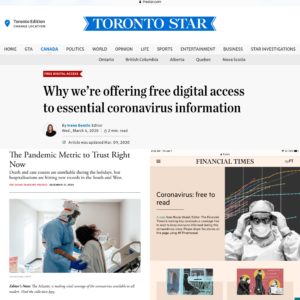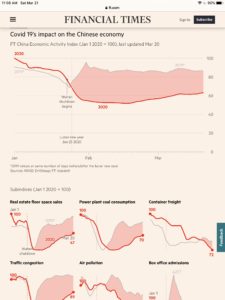 One of the silver linings among the many dark clouds of 2020 was the large number of newspapers and magazines that made their pandemic-related content freely available to all readers.
One of the silver linings among the many dark clouds of 2020 was the large number of newspapers and magazines that made their pandemic-related content freely available to all readers.
Their excellent, fact-checked, professionally-written content is usually behind a paywall. Some newspapers and magazines give readers access to a few free articles each month, with the hope that a paid subscription will follow.
The decision, by many mainstream media organizations to act in the public interest, and lower the paywall on their COVID-19 content, has meant that during the pandemic, the public has had free access to articles by some of the world's best journalists, illustrators and science writers, including:
- In-depth Canadian reporting by Kate Allen and her colleagues at the Toronto Star newspaper
- Ed Yong's brilliant long-form writing at The Atlantic Monthly magazine, together with many other fabulous writers, like Robinson Meyer and Prof. Zeynep Tufekci.
- The Financial Times newspaper's Visual & Data Journalism team's excellent COVID-19 data graphics. The team includes John Burn-Murdoch, whose early data visualizations I found to be very clear and informative.I was impressed at how Mr. Burn-Murdoch openly welcomed feedback from readers, and how he and his colleagues subsequently adapted the databases and metrics that they used in graphs and illustrations. As an academic, I especially appreciate that they always reference their data sources.
Open Access: hotly contested in Higher Education for years
These media organizations made their COVID-19 content Open Access in the public interest. Outside of academia, most people probably bump up against the Open Access conversation with respect to how they access music and movies. I'm talking about piracy. People know they should pay for content, but... downloading pirated content saves money, even if the artists and musicians who create content need to eat, and pay rent, right? No, not ok, although some kinds of free access ARE desirable.
Piracy and the protection of Intellectual Property is the opposite side of the higher education sector's Open Access movement. For well over a decade, the higher education sector has hotly debated who should have free access to scholarly research. For-profit journal and book publishers are asking people, mainly university libraries and students, to pay for access to research that has usually been funded by governments, and non-profit organizations. The academics who write the books and articles generally don't make much money from their publications. I can attest to this.
In 2014, my colleague, Andrea Kosavic asked what the cost of a research essay would be if students had to pay for the journal articles. Students' tuition fees are used, in part to buy access to these journals from within a university's paywall. But once they graduate, students often discover, to their dismay, that they must now pay to read that same writing. Unfortunately, Andrea posted her article to Google+ which is no longer available. But, it's easy to calculate that writing a term paper which asks for 10 peer-reviewed journal articles to be cited would cost about CAD $400 today, if the articles were not open access.
What would the cost of your last term paper be w/o library access? http://t.co/YR69ZgYorO #oaweek @JeanetteAnneH @dawnbazely @yorkulibraries
— Andrea Kosavic (@akosavic) October 20, 2014
I cover the topic of Open Access in my undergraduate biology courses. The Open Access ecosystem is vast, and includes Open Data, Open Educational Resources, Open Source Code, and even Wikipedia. Open Access is fundamental to good science and scholarship across the higher education sector, and issues of equity and human rights are part of the conversation about who has access to this knowledge. During past ebola outbreaks, some important science research lay behind academic journal paywalls. It was not accessible to scholars in Africa at universities with poorly-funded libraries.
Most students learn about these issues for the first time when they take my courses. They also learn about how and why quality writing, data and research costs money, and that the question of who profits from this work, and what fair prices might be for the editing and publishing of articles and books, is still unresolved.
However, these days, many granting agencies do require their funded research to be made available in Open Access journal papers, so academia is making progress in this important conversation.
Paying for quality news content
The past year, 2020 has showed us that the paywall debate isn't just academic. The search for free internet content drives many people to consume information that is plain wrong, and is written and promoted by conspiracy theorists, and biased organizations like right-wing Breitbart News. (update: see Facts won't fix this: experts on how to fight America's disinformation crisis by Lois Beckett in The Guardian, January 1, 2021).
There's a saying in cyberspace: "if it's free online, then you are the product". Many people still do not comprehend the extent to which their online choices and clicks drive data algorithms, allowing companies like Facebook to make enormous profits from their behaviour by targeting ads and biased information towards them.
I hope that if you're reading this, that you consider taking out paid subscriptions to support some of the excellent journalism that has been made open access during this pandemic. Over the course of 2020, I added several new newspaper and magazine subscriptions to my regular group.


